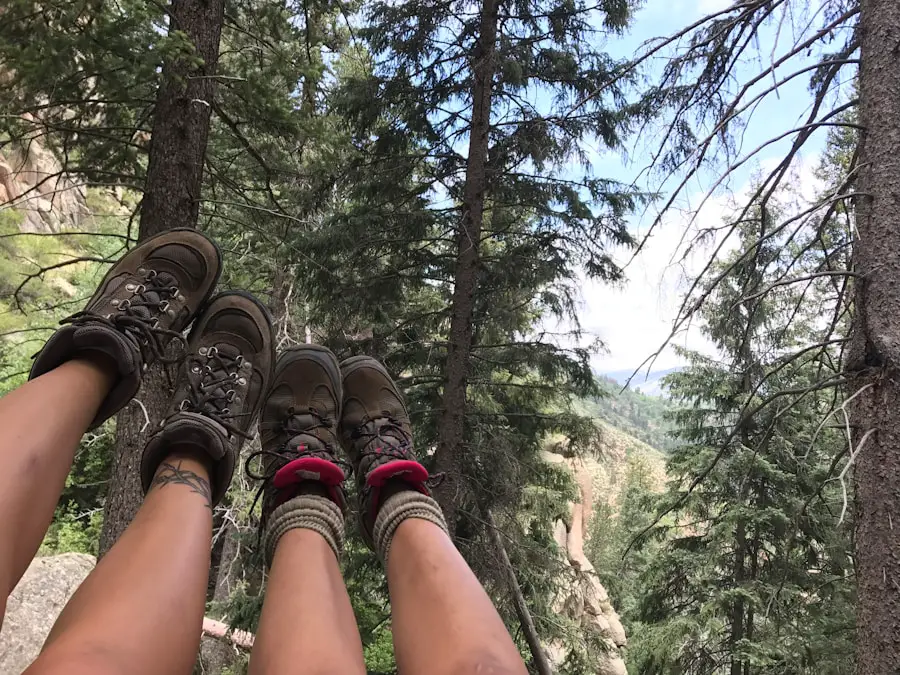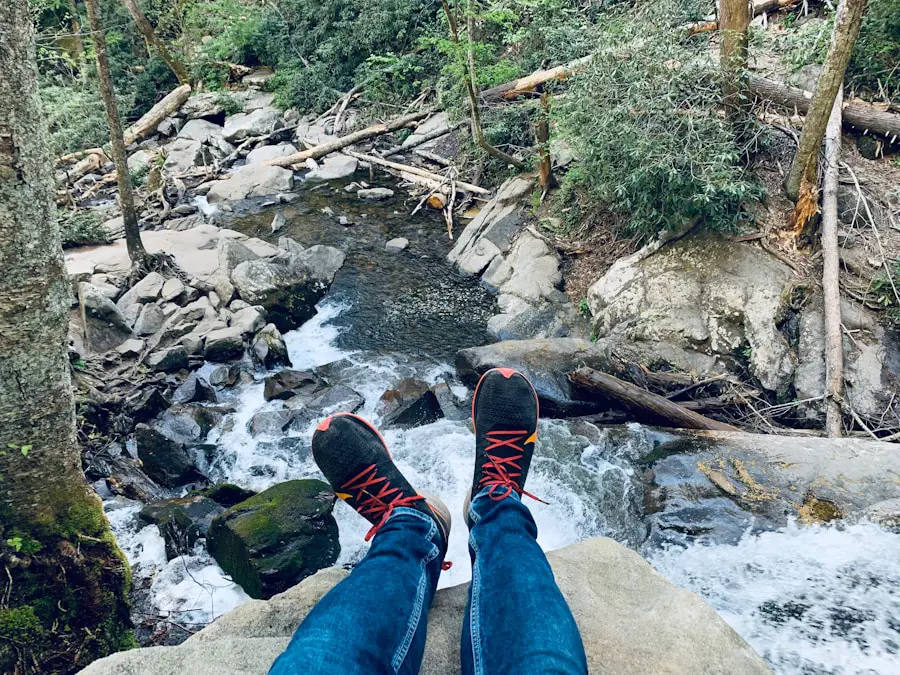Properly fitting hiking boots are crucial for any outdoor enthusiast, as they serve as the foundation for a comfortable and enjoyable hiking experience. A well-fitted boot not only enhances performance but also significantly reduces the risk of injuries such as blisters, calluses, and even more severe conditions like plantar fasciitis. When hiking, the feet undergo various stresses, including changes in terrain, elevation, and temperature.
A boot that fits correctly accommodates these changes, providing the necessary support and stability. For instance, a boot that is too tight can lead to numbness and pain, while one that is too loose may cause excessive movement of the foot within the boot, resulting in blisters and discomfort. Moreover, the right fit can enhance your overall hiking experience by improving your confidence on the trail.
When your feet are comfortable and well-supported, you can focus on the beauty of your surroundings rather than the pain in your feet. This is particularly important during long hikes or multi-day treks where fatigue can set in quickly. A good fit also allows for better energy transfer from your feet to the ground, which can improve your efficiency and speed on the trail.
Therefore, investing time in finding the right pair of hiking boots is essential for both novice and experienced hikers alike.
Key Takeaways
- Properly fitting hiking boots are crucial for comfort, support, and preventing injuries during outdoor activities.
- Factors such as material, construction, and foot shape can affect the stretching of hiking boots over time.
- Techniques for stretching hiking boots include using a boot stretcher, wearing thick socks, and applying a stretching spray.
- Signs that your hiking boots may need stretching include discomfort, blisters, and pressure points on the feet.
- Common misconceptions about stretching hiking boots include the belief that all materials can be stretched and that DIY methods always work.
Factors That Can Affect the Stretching of Hiking Boots
Several factors can influence how much a pair of hiking boots will stretch over time. One of the primary factors is the material from which the boots are made. Leather boots, for example, tend to stretch more than synthetic materials like nylon or polyester.
Full-grain leather is particularly known for its ability to conform to the shape of the foot over time, providing a custom fit that can enhance comfort. Conversely, synthetic materials may not stretch as much but can offer other benefits such as lighter weight and quicker drying times. Another significant factor is the construction of the boot itself.
Boots with a stiffer sole or a more rigid upper may resist stretching compared to those designed with flexibility in mind. Additionally, the thickness of the material plays a role; thicker materials may take longer to stretch and may require more effort to achieve a comfortable fit. The way a boot is constructed—whether it has a waterproof lining or additional reinforcements—can also affect its ability to stretch.
Understanding these factors can help hikers make informed decisions when selecting boots and when considering stretching techniques.
Techniques for Stretching Hiking Boots

There are several effective techniques for stretching hiking boots to achieve a better fit. One common method involves using a boot stretcher, which is a device designed specifically for this purpose. Boot stretchers come in various shapes and sizes, allowing them to target specific areas of the boot that may be too tight.
By inserting the stretcher into the boot and turning the handle, you can gradually widen the boot’s fit without damaging its structure. This method is particularly useful for addressing localized pressure points, such as across the toes or at the heel. Another popular technique involves using heat to facilitate stretching.
This can be done by wearing thick socks and then putting on the boots while using a hairdryer to apply heat to tight areas. The heat softens the material, allowing it to stretch more easily as you walk around in them. It’s important to be cautious with this method; excessive heat can damage certain materials or cause them to lose their waterproof properties.
Additionally, some hikers opt for professional stretching services offered by outdoor retailers or cobblers, which can provide tailored solutions based on individual needs.
How to Determine If Your Hiking Boots Need Stretching
| Signs | Explanation |
|---|---|
| Tightness | If your boots feel too tight, especially in the toe box or around the arch, they may need stretching. |
| Discomfort | If you experience discomfort or pain while wearing your hiking boots, it could be a sign that they need stretching. |
| Blisters | Frequent blisters or hot spots on your feet while hiking in your boots may indicate that they are too tight and need stretching. |
| Difficulty Walking | If you find it difficult to walk or move comfortably in your hiking boots, they may need stretching to provide better flexibility and fit. |
Determining whether your hiking boots need stretching requires careful observation of how they fit during use. One of the most telling signs is discomfort or pain in specific areas of your feet after wearing them for an extended period. If you notice persistent pressure points or areas where your skin feels irritated or blistered, it’s likely that those sections of the boot are too tight and may benefit from stretching.
Additionally, if you find yourself frequently adjusting your socks or shifting your feet within the boots while hiking, this could indicate that they are not fitting properly. Another indicator is how your toes feel inside the boot. Ideally, there should be enough room for your toes to wiggle slightly without feeling cramped.
If your toes are constantly pressed against the front of the boot or if you experience numbness, it’s a clear sign that stretching may be necessary. Furthermore, pay attention to how your heel fits; it should remain snug without lifting excessively when you walk. If you experience heel slippage or excessive movement, this could also suggest that adjustments are needed to achieve a better fit.
Common Misconceptions About Stretching Hiking Boots
There are several misconceptions surrounding the stretching of hiking boots that can lead to confusion among hikers. One common myth is that all boots will stretch significantly over time, regardless of their material or construction. While it’s true that many boots will conform somewhat to the shape of your foot with wear, not all materials stretch equally.
For instance, synthetic boots may not stretch much at all compared to leather ones. This misconception can lead hikers to purchase boots that are too tight under the assumption that they will loosen up with time. Another prevalent myth is that stretching a boot will compromise its structural integrity or waterproof capabilities.
While improper stretching techniques can indeed damage a boot, when done correctly—such as using appropriate tools or professional services—stretching can enhance comfort without sacrificing performance. Many hikers fear that altering their boots will lead to decreased support or durability; however, with careful attention and proper methods, it is possible to achieve a better fit while maintaining the boot’s essential qualities.
When to Seek Professional Help for Stretching Hiking Boots

While many hikers may attempt to stretch their boots at home using various techniques, there are situations where seeking professional help is advisable. If you have tried multiple methods without success or if you are unsure about how to proceed without damaging your boots, consulting a professional cobbler or an outdoor gear specialist can provide valuable insights and solutions tailored to your specific needs. Professionals have access to specialized equipment and techniques that can effectively stretch boots without compromising their integrity.
Additionally, if you have specific foot conditions such as bunions or hammertoes that require careful consideration during stretching, professional assistance is highly recommended. A trained expert can assess your foot shape and recommend appropriate modifications or stretching techniques that address your unique concerns while ensuring that your boots remain functional and supportive.
Tips for Maintaining the Shape and Fit of Stretched Hiking Boots
Once you have successfully stretched your hiking boots to achieve a better fit, maintaining their shape and comfort becomes essential for long-term use. One effective strategy is to regularly clean and condition leather boots with appropriate products designed for outdoor footwear. This helps preserve their flexibility and prevents cracking or drying out over time.
For synthetic materials, using a damp cloth to wipe away dirt and debris can keep them looking good while ensuring breathability. Another important tip is to store your boots properly when not in use. Avoid leaving them in direct sunlight or damp environments, as these conditions can warp their shape or degrade materials over time.
Instead, store them in a cool, dry place with adequate ventilation. Using boot trees or stuffing them with newspaper can help maintain their shape during storage. Additionally, rotating between multiple pairs of hiking boots can reduce wear on any single pair and prolong their lifespan.
Alternative Options for Finding the Right Fit in Hiking Boots
If stretching does not yield satisfactory results or if you prefer not to alter your existing boots, there are alternative options available for finding the right fit in hiking footwear. One approach is to explore different brands and models that cater specifically to various foot shapes and sizes. Many manufacturers offer wide or narrow options within their product lines, allowing hikers to find a pair that fits comfortably without needing extensive modifications.
Another alternative is to consider custom insoles or orthotics designed specifically for hiking boots. These inserts can provide additional arch support and cushioning tailored to your foot’s unique contours, enhancing overall comfort without requiring significant changes to the boot itself. Additionally, some outdoor retailers offer fitting services where trained staff can assess your foot shape and recommend suitable options based on your specific needs and preferences.
In conclusion, understanding the importance of properly fitting hiking boots cannot be overstated; they are essential for comfort and performance on any trail. By recognizing factors affecting stretching, employing effective techniques for adjustments, and knowing when to seek professional help, hikers can ensure their footwear remains supportive throughout their adventures. With proper care and maintenance, stretched boots can continue to provide reliable performance while exploring nature’s wonders.
If you’re an avid hiker, you may be wondering if hiking boots stretch over time. According to a recent article on TakeTravelInfo, hiking boots can indeed stretch with wear and use. This can be especially helpful if you find your boots feeling a bit tight initially. By breaking them in gradually and allowing them to stretch naturally, you can ensure a comfortable fit for all your outdoor adventures.
FAQs
What are hiking boots made of?
Hiking boots are typically made of leather, synthetic materials, or a combination of both. The materials used can affect the stretchiness of the boots.
Do hiking boots stretch over time?
Yes, hiking boots made of leather can stretch and mold to the shape of your feet over time with regular use. Synthetic materials may have some stretch, but not as much as leather.
How can I stretch my hiking boots?
You can stretch your hiking boots by wearing them around the house with thick socks, using a boot stretcher, or taking them to a professional cobbler for stretching.
Can all hiking boots be stretched?
Not all hiking boots can be stretched, especially those made of synthetic materials or with a rigid construction. It’s best to check with the manufacturer or a professional cobbler before attempting to stretch your boots.
How much can hiking boots stretch?
The amount of stretch in hiking boots can vary depending on the materials used and the construction of the boots. Leather boots can stretch up to half a size or more, while synthetic boots may have limited stretch.
